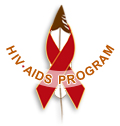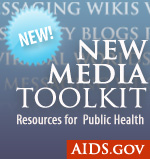Responding to HIV in the Native Community: Part I
Last week, we gave a presentation on new media and American Indians and Alaska Natives (AI/AN) to the Office of Clinical and Preventive Services (OCPS) at the Indian Health Service. As Captain Scott Giberson, IHS HIV Principal Consultant, and Lt. Commander Dwayne Jarman, IHS Prevention Specialist, told us, “IHS is the Federal agency that fulfills the U.S. government’s responsibility for health among AI/AN communities. New media can enhance our ability to fulfill that role.” The presentation led us to some interesting findings and resources that we’d like to share with you in this week’s post.
What are the facts about American Indians and Alaska Natives and HIV/AIDS?
(Facts from the CDC’s Fact Sheet on HIV/AIDS among American Indians and Alaska Natives)
While AI/AN with an HIV or AIDS diagnosis represent less than 1% of the total number of HIV/AIDS cases reported to the CDC, when population size is taken into account, AI/AN ranked third in rates of HIV/AIDS diagnosis, after African Americans and Hispanics. The rate of AIDS diagnosis for this group has been higher than that for whites since 1995.
What do we know about American Indians and Alaska Natives and new media use?
It is challenging to find numbers that represent how many AI/AN are online or using new media. As one report assessing Internet access across the Indian Health Service (PDF 6.59 MB) states, “there are few data available on the number of AI/AN who have Internet access.” To learn more, we spoke with several leaders in the field from The Native Capacity Building Assistance Providers’ Network.
- An IHS report (PDF 6.59 MB) found “of those who seek health care services at IHS locations, 1 in 5 have Internet access; in the general population 3 in 4 have Internet access.” Dr. Pamela Thurman, Project Director/Senior Research Scientist at the Commitment to Action for 7th-Generation Awareness & Education: HIV/AIDS Prevention Project
 , reminded us that “often even those who are listed as having Internet access are utilizing dial-up or very, very slow wireless, which greatly limits their access.”
, reminded us that “often even those who are listed as having Internet access are utilizing dial-up or very, very slow wireless, which greatly limits their access.” - The National Center for Educational Statistics reports that 24% of AI/AN students use the Internet at home. Gwenda Gorman, Health Promotions Director, and Diana Mitchell, CBA Coordinator, of the Inter Tribal Council of Arizona, Inc.
 told us, “Currently, the younger generation has the capabilities to use such technology. For the older/Elder generation, it can be a new process that may be difficult to learn.”
told us, “Currently, the younger generation has the capabilities to use such technology. For the older/Elder generation, it can be a new process that may be difficult to learn.”
Next week we’ll discuss how to reach AI/AN using new and traditional media, with additional insight from the National Native American AIDS Prevention Center  .
.
We’ll also be including examples from the field—so please leave a comment to let us know what you’re doing with the AI/AN community!
If you enjoyed this post, please consider leaving a comment or subscribing to the feed to have future articles delivered to your feed reader or email.








Nice article,
Through the Healthy Native Community Fellowship, the Health Promotion Disease Prevention program has used Sharepoint Services 3.0 (http://www.hncp.org/wst/hpdp/headquarters/default.aspx) over the past several years; this system allows for visitors to sign up for RSS feeds to obtain new content posted. The Healthy Community Natives Fellowship workstation is being revised to allow for video and podcasts; currently we are experimenting to make sure that we are providing up to date and accessible media for our target audience. See this closed captioned google video (http://video.google.com/videoplay?docid=777340888538407710&hl=en) as an example of how we are trying to create content we believe our target population will be interested in. While this video is not 100% what we want it to be, it exemplifies how we are trying to achieve quick and easy ways to send out information to those interested.
Lastly, Capt Giberson and I are working to help make new media near the top of our communication list. We welcome any and all feedback on how to best achieve this goal using both Mac OS X and Windows platforms. Please feel free to email me at Dwayne.Jarman@ihs.gov
- Dr. Dwayne Jarman, Indian Health Service.
Posted by: Dwayne Jarman | January 14, 2009 at 08:38 AM
A number of misconceptions have arisen surrounding HIV/AIDS. Three of the most common are that AIDS can spread through casual contact, that sexual intercourse with a virgin will cure AIDS, and that HIV can infect only homosexual men and drug users. Other misconceptions are that any act of anal intercourse between gay men can lead to AIDS infection, and that open discussion of homosexuality and HIV in schools will lead to increased rates of homosexuality and AIDS
Posted by: Yemek Tarifleri | February 04, 2009 at 08:17 AM
Dr. Jarman, it's exciting to hear that you're using SharePoint Services to spread the word about something this important. As a marketing consultant and true believer in Social Media and using podcasts as a content delivery method, I applaud how you embrace this technology. My hat's off to you.
Andrea Kalli
http://www.virtualassist.net
Posted by: Andrea Kalli | April 13, 2009 at 10:44 PM